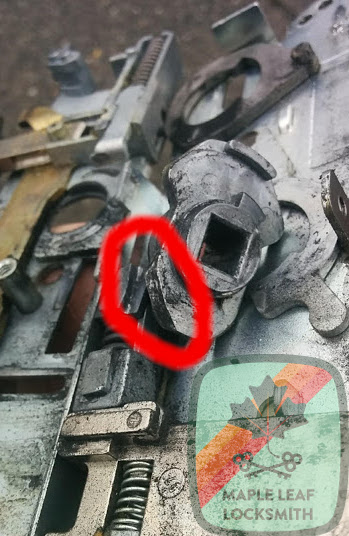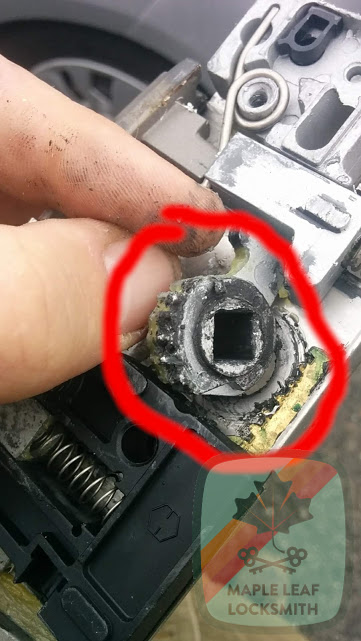- $120 Local trip charge to North Seattle each time I come out. If we order a replacement I will need to come out twice.
- $95 per hour installing or replacing multipoint locks
- $35 per cylinder to rekey multipoint locks. Assuming a conventional keyway. Some multipoint locks have high security or restricted keyways. I also sell replacement profile cylinders in conventional residential keyways and Abloy Protec2 high security keyway.
Multipoint locks are complicated and therefore expensive. Despite being expensive, they are generally complicated in design and yet manufactured with weak alloys. I can come out and look at your multipoint lock, take it out and measure it for replacement, rekey it, or replace the lock cylinder with a higher security one. I charge twice as much to rekey them. Replacement cylinders are more expensive for these too.
Multipoint locks, unlike the locks we in the USA are used to, extend the entire length of the door. There are often bolts that come out of the top and bottom of the door, or there may be tongues or rollers that lock the door at the top and bottom on the side of the door. This makes the door much more secure than a similar door with only a deadbolt and a doorknob. Never mind that multipoint locks are almost always installed on doors with a six foot by three foot pane of glass. My customers frequently comment that the cost to replace one of these locks highly secure locks is ridiculous when somebody might toss a mason block through the giant pane of glass and simply walk through the door.
I won’t argue:
- They have components made of weak alloys that seem designed to fail.
- Despite being so expensive, they are installed on doors with large panes of glass that if broken could be walked through.
I am no metallurgist but I repair locks and when I find out what broke in one of these locks it is usually not a part made of steel or brass. It is usually made of a zinc alloy. The most common point of failure with these in my experience are gears with broken teeth.
These teeth could break off from regular usage. These doors are usually installed with weatherstripping and so to lock the door one has to pull up on the lever to lock the multiple points rather hard. If the strikes aren’t installed correctly, people might compensate by pulling up on the levers really hard. That force is transferred to the locking points via those gears cast in zinc.
That is assuming that whoever is locking the door even understands how to use these strange European import locks. Seattle is always a place in a state of flux and people don’t always get an introduction to the patio lock in their new house. You usually have to
- Close the door all the way.
- Lift up on the handle on the inactive door if there is one to lock its bolts first.
- Lift up on the active door’s handle to lock its multipoint locks
- Finally, to prevent somebody from unlocking the door from the outside by pushing down on the lever on the outside of the door, you then use the thumbturn if there is one to lock the door.
This is far more complicated than the locks that Americans are used to, so the confusion that results with this more complicated locking process results in frustrated residents and guests forcing the thumbturn without lifting up on the handle first, or trying to force the lever down without retracting the deadbolt first. Damage is compounded when there is alcohol involved. These locks don’t last long on an AirBNB with a view. One group of rowdy drunk guys will absolutely destroy these locks.


You can see from the picture that these locks are somewhat complicated with little springs that don’t want to stay where they are supposed to. To even open these up you sometimes need special security bits and often need to break rivets. That is to say they are often not designed to be serviced. They don’t want you to open them up and tinker with them. Better to buy a $350 replacement part!
Let’s say you do want to fix your broken multipoint lock – first you will need to figure out what kind it is. First things first, check if it is under warranty. If you bought it check your receipt. Warranty might last ten years on one of these. If it isn’t, look for identifying model numbers in the paperwork or on the lock itself. This allows you to order the exact replacement. There are a lot of different measurements for these locks. Unlike American tubular locks which are somewhat universal with only two normal backsets, there are about twenty different measurements that come into play with multipoint locks. There is no standard with these; the door manufacturer often makes the lock too and they have an incentive to make sure a competitor’s locks don’t work in their door!
You have to measure the width of the lock on the edge of the door, the backset, the length from the floor to the handle, the middle of the handle’s spindle hole to the middle of the lock cylinder, the length from the handle to the lower point, to the upper point, the distance from latch to bolt, door thickness, etc.
If you get one of these things wrong it isn’t a drop-in replacement anymore. In fact, many of these aren’t manufactured anymore and the best you can do is to get close and make a minimum of modifications to the door and frame.
If you are still with me, these locks are a giant PITA. That is why many locksmiths refuse to deal with them. One wrong measurement and you have to mail it back and pay a restocking fee. Customers often can’t or refuse to understand why the lock costs so much to replace in parts and labor.
I do replace these. Sometimes I am able to fix them. Occasionally there are easy fixes that are inexpensive. Don’t count on that though! If you are looking for replacement parts, the best website that I’ve found is all about doors and windows. They have provided in depth instructions on measurements and when direct replacements aren’t available, the closest one with a minimum of modifications. Not necessarily the cheapest but in my experience the easiest and quickest to find the correct part for a reasonable price.
